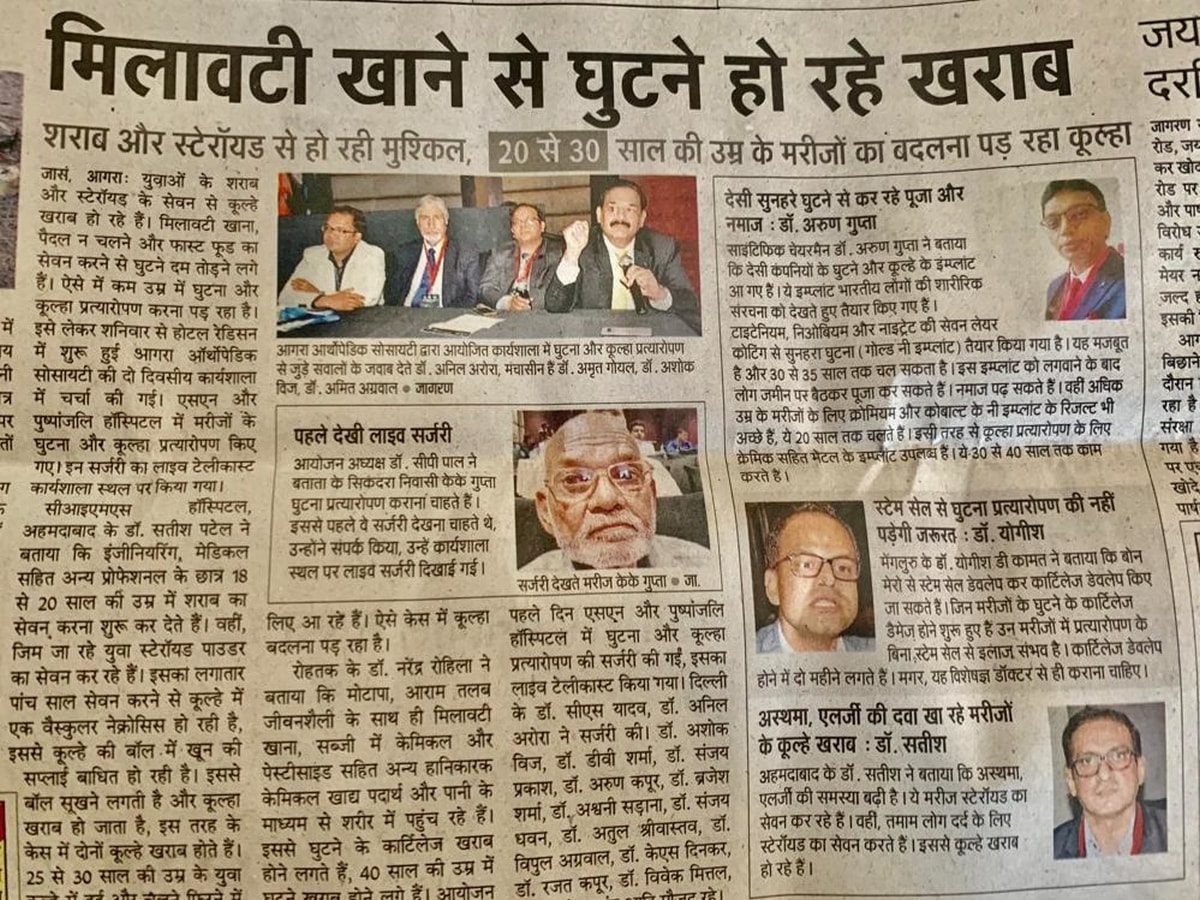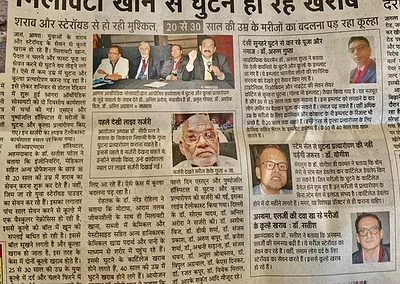We all derive knowledge from various sources right from hearsay, books, the media (radio, television, newspapers) to the ever- increasing use of the internet. Technology is rapidly developing and new interventions in healthcare enable cure of previously untreatable diseases. Who would have thought 15 years ago that patients confined to wheelchairs could not only get up and walk but drive a car or do the shopping on their own? We now enable this routinely, even for 80 year olds and above. We are at a level of research now that we might be able to eliminate big operations and treat arthritis using stem cell technology, if detected at an early stage.
The term ‘arthritis’ itself encompasses a range of different stages and types of disease for which an equal range of treatments exist. Rheumatoid Arthritis is a variation which itself has many types in which might not be detected by blood tests contrary to what people and many medical practitioners feel. This arthritis can be completely controlled with medication. On the other hand, wear and tear related ‘Osteoarthritis’ may be controlled with exercise, but not cured with medication. What treatment would be applicable to whom could only be determined following thorough examination by an appropriate specialist on the subject. When undertaking treatment, it is most important that the patient participates in his or her therapy. A comprehending patient is as important as the doctor who has instituted the treatment.
There remains lack of knowledge on new developments and persisting reliance on old therapies. We hence continue to see severely disabled patients who have not had appropriate treatment, even among the higher socio-economic group. Financial limitation and resulting inability to access appropriate treatment is undoubtedly a problem too. In this scenario, the role of media in relaying information to the masses is vital. There is however no standardization of relayed or published material. Similarly, is the media effective in relaying complete information regarding healthcare schemes? Or are our advertisements luring people into trial of certain scientifically unproven treatments? In this situation, the reliability of such sources becomes questionable. Loss of credibility of any single media source leads people running from pillar to post to verify information themselves. It also results in lack of trust in the healthcare provider.
Information & Advertisement:
Indians are culturally accustomed to miracles as we relate to our mythology. We might hence be keen to hear flashy and sensational news, which reflects in our media. We mostly see publication of case reports e.g. how a difficult case was managed by a particular team. What such reports don’t mention is whether the case in question was rare or whether such cases are being routinely undertaken at a similar facility. To explain this further, if a complex case has been managed for the first time, it is a very good thing. However, it does not give us fool proof that the facility is capable of managing any similar case and how common such cases are. Indian law does not allow doctors to advertise individually. Hospitals or other establishments however have no such restriction. Healthcare and beauty products are in fact the largest chunk of printed advertisements. These claim to work wonders, often with mudslinging of competitive brands. Many advertisements use patient models too, especially with alternative medicine treatments. People flock to these as they think there will be no side effects. It is surprising to note how many cases fail exotic treatments due to long term side effects and get complicated, making them difficult to manage effectively at the second stage.
Comprehensive informative articles about a certain disease condition provide a more realistic view and these need to be encouraged. The good ones from these would enlist various treatments available and describe the merits and demerits of each. Similarly, information related to a group of cases treated successfully makes for substantially more evidence. It would be ideal to describe the failures or setbacks encountered in treatment and the centers equipped for managing such treatments routinely. There should be complete information at the common man’s understanding level, exactly like experts derive from expert books or scientific papers on the subject.
Arthritis & Alternative medicine:
Various systems of medicine are successfully practiced in India. Ayurveda is the oldest of these and describes treatments which have held their ground over time. The most widely successful among these treatments are certain massages and local application therapies which work wonderfully for muscle spasms, pain and arthritic flare ups. The old system also incorporates principles of Naturopathy, yoga, diet and exercise which are known to work well and completely cure early stages of disease if followed well (even accepted in the recommendations of the American Association of Orthopaedic Surgeons) These are however up to the patient to follow as much as they are the responsibility of the practitioner to teach. Oral medications could cause long term side effects even though they are advertised otherwise. Similarly, there isn’t enough scientific evidence to prove the beneficiary effect of other treatments like magnetic fields and belts among other rampant ones.
New surgical techniques and Stem Cells:
There is continuing innovation and improvisation in the surgical field. It is necessary to employ these to enable better treatments. A new surgical treatment, like a new drug, undergoes a trial phase. While trials of new drug combinations are a strict legal requirement, modifications of prostheses find their way into use for patients without monitoring measures in place. It has been the history of joint replacement surgery to see a few unsuccessful prostheses and failures. Patients have a right to ask and get an exact record of what implant has been used for their surgery. Similarly, as joint replacement is one of the most successful surgeries enhancing life quality, there are published long term success results with many prosthesis designs across the world. Using a new expensive implant or technique without long term evidence or experience is not necessarily justified. Similarly, many imported implants are not standard and researched, so just asking for imported and criticizing some good indigenous ones does not make sense. Patients can have a detailed discussion with their treating doctor about options here.
Use of stem cells is an exciting advancement for arthritis as it is for various other treatments. This might work in preventing joint replacement if successfully employed in the early stages of arthritis. It might be proclaimed otherwise and result in failures. In the current time, their use must therefore be with caution. In short, they are largely for the younger patient and to prevent severe arthritis. Joint replacement is the scientifically proved and successful measure for severe arthritis and conversely, not the treatment for early stage. Many of us researchers are jointly collaborating towards the advancement of these techniques.
Doctors, their media image
There has been rampant display of distrust against doctors in the recent past. Most of these breaches of the doctor patient confidence can be rooted to a gap in communication of information. Some proposed legislations are also looking at monitoring medical practice more strictly as well as enforcing stronger penalties. While we already have a number of such regulations in place already, it is rather of greater importance that we enforce the regulations already in place and institute higher standards of practice and communication. Doctors’ associations countrywide are realizing the deficit and taking up the cause to educate patients in the right sense so as to make their own right choice of treatment.
The future?
Countries like the United Kingdom have set up free online information access regarding outcome of treatment in their hospitals. This enables patients to make their choice and monitor the results of treatment at a particular center. It could become a benchmarking for various hospitals to live up to in terms of standard of care. Working on these clinical index measures and regular publication by the hospital would effectively help give seamless scientific information.
We could have better regulation on the quality aspect of healthcare rather than allowing trial and testing with unhealthy commercialization that currently exists. While advertisements are necessary for the media to sustain themselves, there could be some regulatory advice or notice on those regarding discussion with the appropriate doctor before trial. The media could develop a great positive impact here by publishing more comprehensive scientific articles and relaying complete information. Similarly, information regarding available schemes and financial support systems needs to percolate better.
Summary
We all derive knowledge from various sources right from hearsay, books, the media (radio, television, newspapers) to the ever- increasing use of the internet. The term ‘arthritis’ itself encompasses a range of different stages and types of disease for which an equal range of treatments exist. What treatment would be applicable to whom could only be determined following thorough examination by an appropriate specialist on the subject. When undertaking treatment, it is most important that the patient participates in his or her therapy. A comprehending patient is as important as the doctor who has instituted the treatment.


